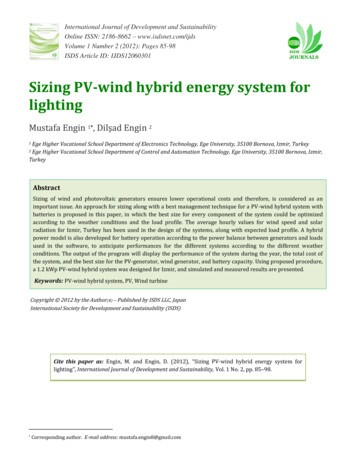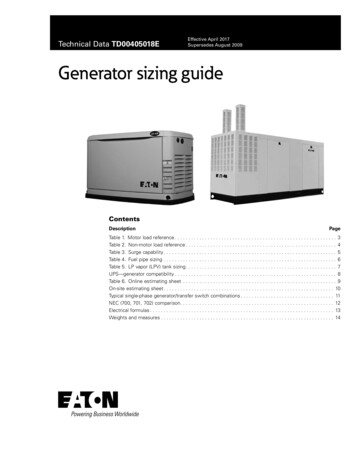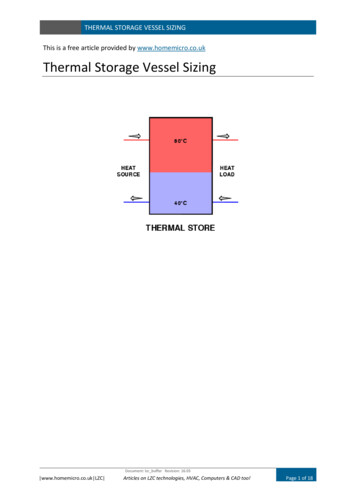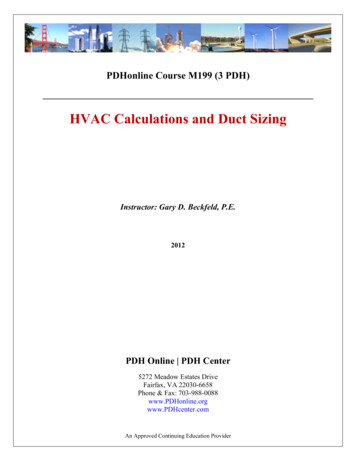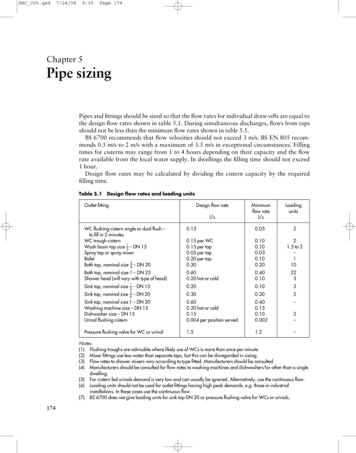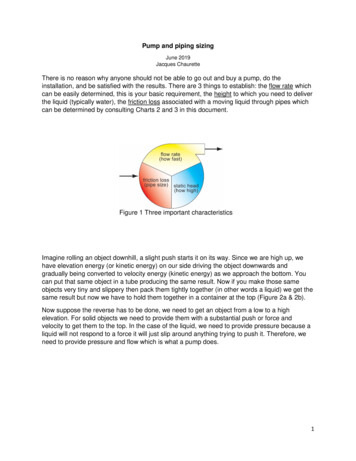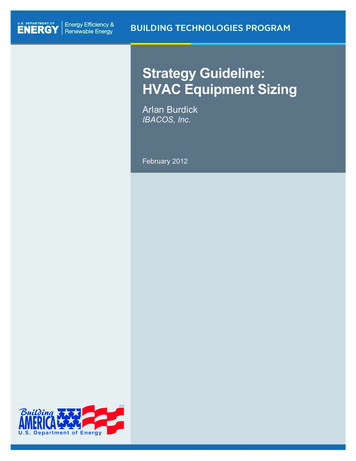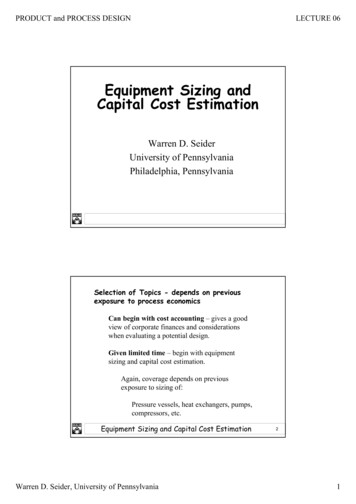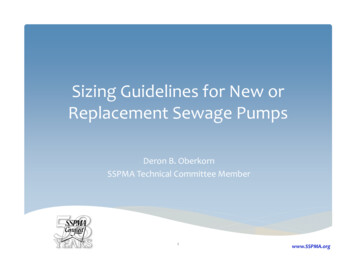
Transcription
Sizing Guidelines for New orReplacement Sewage PumpsDeron B. OberkornSSPMA Technical Committee Member1www.SSPMA.org
SSPMASump and Sewage Pump Manufacturers AssociationSince 1956, we are a North American trade organization of sump, effluent,and sewage pump manufacturers and their suppliers.Working together to: train wastewater and plumbing professionals, and create product performance and safety standards.SSPMA members collaborate with each other and government regulators toeducate consumers and professionals on the latest products, theirapplication, proper sizing techniques, safe installation and use, and goodmaintenance practices.2www.SSPMA.org
SSPMA MEMBERSBarnes Pumps / Crane Pumps & SystemsChampion Pump Company, Inc.Franklin Electric / Little GiantGlentronics Inc.Goulds Water Technology, a xylem brandLiberty PumpsPentair WaterSuperior Pump CompanyZoeller Company3www.SSPMA.org
SSPMA ASSOCIATE MEMBERSAlderon IndustriesCampbell Manufacturing Inc.John Crane, Inc.Motor Protection Electronics, Inc.SJE‐Rhombus4www.SSPMA.org
Sizing Guidelines for New orReplacement Sewage Pumps Topics covered Pump Capacity RequirementsTotal Dynamic Head (TDH)Solids Handling RequirementsBasin SelectionSimplex and Duplex SytemsSizing Example5www.SSPMA.org
Pump Capacity Requirements Based upon water generating fixtures Each fixture rated in “Fixture units” Compilation of fixture units creates max system capacity Pump must remove min of max system capacity Pump is part of a system Three components Pump, Control, Container6www.SSPMA.org
Pump Capacity RequirementsFixture unit and flow curvesResidential Fixture UnitsBathroom group flush tankWater closet - flush TankLavatoryBathtub ‐ privateShower StallSink ‐ kitchenGarbage disposalDishwasherWashing machineLauntry Tray63122221237www.SSPMA.org
Total Dynamic HeadDefinition:Total Dynamic Head is a compilation of resistance to statichead and the flow through a constrained device or devicesat a given flow rate. Also known as TDH.Components:Static Head ‐ Vertical lift to the point of discharge (POD)Horizontal run – Distance in horizontal vector to (POD)Minor Losses – Resistance through pipe, fittings, and valves.Formula: Vertical Lift (Horizontal Run Minor Loses)8www.SSPMA.org
TDH Calculations Formula: Vertical Lift (Horizontal Run Minor Loses) Horizontal Minor losses call “Equivalent Length” Vertical Lift – Lift in feet from discharge point of device to gravity Equivalent Length starts with flow rate from system capacity. This will be combined with Pump capacity to identify the right pump9www.SSPMA.org
Solids Handling RequirementsTwo types of sewage PumpsSolids handlingGrindersA solids handling pump is designed to pass a specific sphericalsolid intact.This requires the flow and pipe diameters meet the pumpsrequirements.A sewage pump will pass a 2” spherical solid.This requires a minimum velocity based upon pipe diameter.10www.SSPMA.org
Solids Handling Requirements11www.SSPMA.org
Solids Handling Requirements12www.SSPMA.org
Basin SelectionMaterialsPolyethyleneLimited to max 36” diameter and 36” deepFiberglass (FRP – Fiber Reinforced Polymer)Virtually unlimited in sizeConcreteUsually come in sections due to weightWeather and soil conditions can hinder install13www.SSPMA.org
Basin SelectionSizingBased upon diameters and depths18” 1.1 gallons / inch depth24” 2.0 gallons / inch depth30” 3.06 gallons / inch depth36” 4.4 gallons / inch depth48” 7.83 gallons / inch depth60” 12.24 gallons / inch depth72” 17.63 gallons / inch depth14www.SSPMA.org
Simplex / DuplexDefinitionSimplex – A single pump consisting of a pump and control inan application without a backup pump.Advantage – lower costDisadvantage – no redundancyDuplex – A dual pump system with a control that alternatesthe pumps and or allows for a simultaneous run of bothunits.Advantage – RedundancyDisadvantage – Higher up front cost15www.SSPMA.org
Sizing ExercisesAvailable assistance with sizing charts and dataSSPMA.org16www.SSPMA.org
Sizing ExercisesApplication #1Residence with 2.5 bath pumping to a septic systemVertical Lift to the septic tank 8’Horizontal run to the septic tank 150’Location of the pump – Basement of houseFittings and accessories:1 – Check valve1 – Gate valve5‐ 90 degree elbows17www.SSPMA.org
Sizing ExercisesFixture units from slide 8Bathroom group flush tank 6Bathrooms 2.5 fixture units 2.5 x 6 15Laundry Tray 3Dishwasher 1Garbage Disposal 2Total Fixture Units 2218www.SSPMA.org
Sizing ExercisesFlow rate from Slide 822 Fixture Units Curve C 10 gpmSince sewage pumps are 2” discharge, minimum flow is 21gpm. Use 25 gpm as a safety factor.Design point to identify the right pump is required forproper sizing.19www.SSPMA.org
Sizing ExercisesFormula: GPM 25TDH Lift (Equivalent Length)TDH:Lift 8’Equivalent Length:((Horizontal run Minor losses) / 100 ) * Friction loss coef)Per SSPMA standards20www.SSPMA.org
Sizing ExercisesEquivalent LengthValves and fittings have equivalent length of pipe coeff2” SizesCheck valve 17.2’Gate Valve 1.4’90 degree elbow 5.2’Friction loss coefficient at 25 gpm in 2” PVC pipe 1.3Per SSPMA standards21www.SSPMA.org
Sizing ExercisesApplication #1FormulaTDH Lift ((Horz Run Minor Losses) / 100) * Fric coeffLift ((Horz Run Check valve (3 x Elbow) * Gate Valve)8’ ((150’ 17.2 (3 x 5.2) 1.4) * 1.3 8’ ((184.2’/100)*1.3) 8’ 4.8’ 12.8’ TDHDesign Point 25 GPM at 12.8’ TDH22www.SSPMA.org
Sizing ExercisesApplication #1Size pump for design pointDesign point 25 gpm @ 12.8’ TDH’Design point must be under the pump / impeller curveLocate design point in middle third of the curve (whenPossible).This is the highest efficiency locationSaves energy, maximizes pump life cycle23www.SSPMA.org
Sizing ExercisesApplication #124www.SSPMA.org
Sizing ExercisesRecommendations: When replacing a pump, do not replace based uponhorsepower. Different pumps apply horsepower and impellersdifferently. Ensure pump and supply voltage match. Always replace check valve when pump replaced. If float switches are used, understand how they operate. Never put receptacles in septic risers.25www.SSPMA.org
Pumps bearing the “SSPMA‐Certified” seal have been testedby the member manufacturer in accordance with SSPMAIndustry Standards.The Standards are designed to provide accurate performancedata for sump, effluent and sewage pumping equipment, toassist in their proper application and selection.26www.SSPMA.org
.Thank youFor additional info go to:www.SSPMA.org27www.SSPMA.org
Sizing Exercises Application #1 Size pump for design point Design point 25 gpm @ 12.8’ TDH’ Design point must be under the pump / impeller curve Locate design point in middle third of the curve (when Possible). This is the highest efficiency location Saves energy, maximizes pump life cycle 23 www.SSPMA.org



